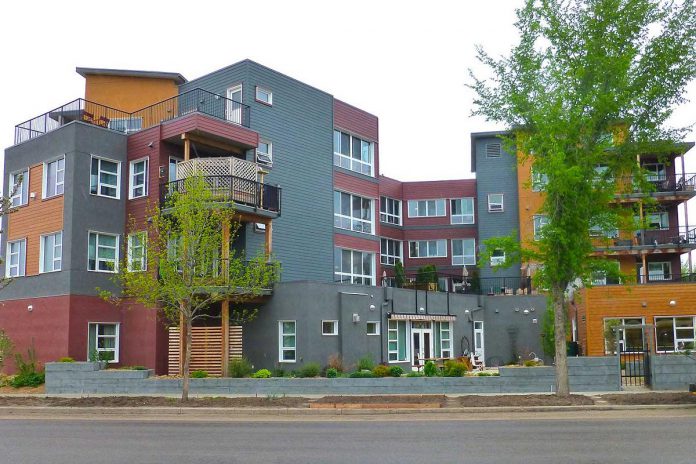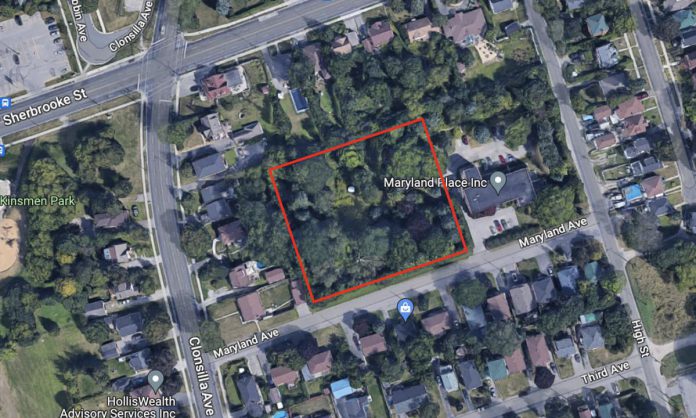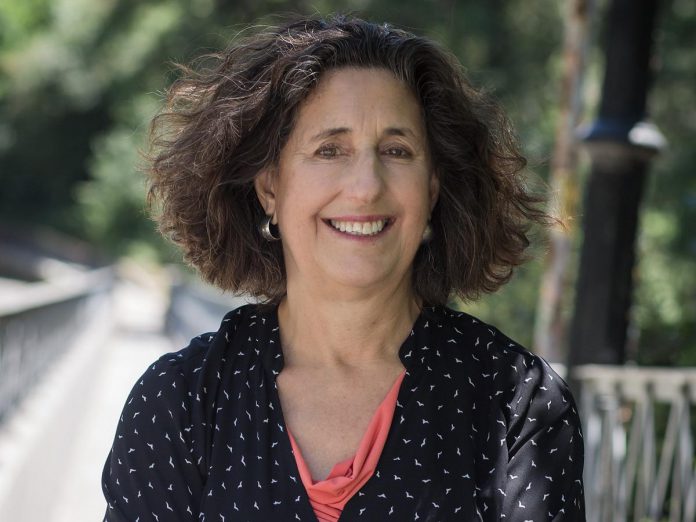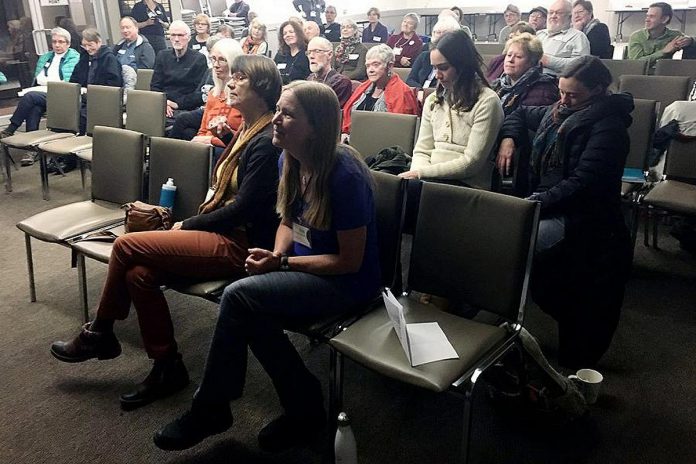
Back in March 2019, Kawartha Commons Cohousing (KCC) confirmed its commitment to design, build, and manage what would be Peterborough’s first cohousing community.
Silence has since followed that public gathering at the Lions Community Centre, but that belied the work being done behind the scenes as KCC explored options moving forward — a big one being the acquisition of property for the development of a multi-storey condo-style building where occupants not only share common facilities but also fully participate in every aspect of the decision-making process that governs their communal living space.
“Housing takes a long time,” KCC president Kris Robinson Staveley tells kawarthaNOW. “Our cohousing consultant (Kathryn McCamant of California-based Cohousing Solutions) said we should assume it’s going to take five to eight years. We didn’t believe that in the beginning. We were sure we were going to be moved in by 2023. That was our vision.”
“Back in 2019, we thought we had a different site — then the pandemic hit and that fell apart,” Robinson Staveley says. “But one of the interesting things through the pandemic was we stayed together as a community. We pivoted to having virtual business meetings but also virtual social gatherings to support each other through the pandemic.”
“We had regular coffee chat gatherings. We had Friday dinners where everybody ate in front of his or her computer screen. Some played music but we discovered you couldn’t really sing along on Zoom. That’s a terrible thing to try to do — nobody can actually harmonize.”
True enough, but now KCC is singing the praises of its acquisition of a 1.4-acre site at 736 Maryland Avenue in Peterborough that, in due time, will be home to a wholly sustainable community for some 40 families.

The site is within walking distance to downtown and close to grocery stores, the hospital, and public schools. Maximizing the preservation and use of existing green space, the development will also house 4,000 square feet of common space to facilitate community gatherings that speak to the very heart of the cohousing concept.
Cohousing’s emergence dates back to the late 1960s when a group of Danish families sought an alternative to their urban lifestyle. The goal was to create a supportive community where each inhabitant knew their neighbours; a sharing community where younger families could thrive in a safe setting while reducing their environmental footprint and older couples could maintain their self-reliance while staving off isolation and feelings of loneliness.
The resulting neighbourhoods were called ‘bofoellesskaber’ — living communities. Today, 10 per cent of all new Danish housing follows the same model.
In 1988, McCamant was one of two architects who introduced the concept to North America, billing it as cohousing. While there are few cohousing communities in Ontario, several have been established south of the border, particularly in California, as well as in western Canada including Saskatchewan and British Columbia.
Going back to 2017, Robinson Staveley and her husband have visited a number of cohousing communities to learn more about the concept.
“People were happy to take the time and give us a tour,” she says. “We asked ‘What were the problems you faced? What challenges did you deal with?’ We tried to really focus on that as well as the success stories and tips for how to do things right. We don’t want to reinvent the wheel. It’s a complex process starting from the ground up. We have gathered a lot of useful information from all kinds of cohousing communities.”

The subsequent acquisition of the Maryland Avenue property in 2023 was the result of a search restarted in 2022. Robinson Staveley says contact was first made with the property owner in 2019, but “We went off in a different direction” and nothing came of it.
The property was the garden of a former convent, now an adjacent multi-unit apartment building called Maryland Place that’s home to seniors on a limited income.
According to Robinson Staveley, there are 12 households “signed up and eager to go, and another three households we call ‘explorers’ — people who have joined us and are in the very early stages of deciding if they want to become equity members.”
“Whether it’s hiring consultants, or buying the land, or doing the design work, or paying the city fees, we have to pay all the costs as we move this project forward,” Robinson Staveley points out. “So far we have covered our costs, which is the important thing.”
“One of the things that is important about cohousing is that it’s very much run by the people who live there. The model we’re going with is we’re the people who find the land. We buy it. We make the decisions about what the design looks like. We design our units. We decide how much common space there is and what type of common space we have.”
“After you move in, it’s not like it’s all done. You have to agree on the rules for the common kitchen. All kinds of things need to be cooperated on. That has its challenges. We’ve spent a lot of time working on our governance system, our decision-making models, because that’s hugely important. You can’t just say ‘Let’s all live together in peace and harmony and we’ll have no conflict.’ That’s not going to happen.”

Robinson Staveley readily acknowledges that cohousing isn’t for everyone.
“The white picket fence and the car in the garage has a lot of individuality built into it,” she says. “Sometimes neighbourhoods work out great and people are really cohesive, but sometimes it doesn’t work out.”
“We like to call this an intentional neighbourhood in the sense that we choose to say ‘Yes, we want to be involved with our neighbours.’ It’s not like engagement is required of you. It’s an option that’s available by having common facilities that are shared, and by having the vision that this is a place where people are there for you if that’s what you want.”
“More than the socializing is the fact that you make decisions together. You have to compromise. When you live in a community, you have think about what’s right for everybody as opposed to what’s right for (you). That aspect of it is certainly part of the process.”
In effort to preserve as much of the existing green space as possible, the plan is to build up in the form of a five-storey building with the ground floor reserved for a common space kitchen and dining room as well as other shared amenities.
“There will also be little gathering nodes on each floor. If you wander outside of your unit and look down the hall, you’ll see people sitting at a table in the sun, catching the last rays of the afternoon and having a beverage of their choice. You can go join them. That’s our vision.”
VIDEO: Cohousing communities help prevent social isolation – PBS NewsHour
Robinson Staveley says while it’s hoped ground will be broken in 2025, a lot has to happen beforehand, including rezoning and site plan approval from the City of Peterborough.
“We’ve done a pre-consultation with the city. They’ve given us a list of studies that need to be done before we can submit for rezoning. We’re hoping we get the schematic design finished this year.”
In the meantime, work will continue creating more awareness of what the cohousing concept is all about and bringing new members in the fold.
To that end, KCC is hosting Zoom information sessions, with the next two scheduled for Saturday, February 3rd and Thursday, March 21st. Topics include why people choose cohousing, an introduction to KCC and preliminary estimated costs, and how to take the next step toward becoming an equity member.
VIDEO: How cohousing can make us happier (and live longer) – Grace Kim
“It has been a long haul,” notes Robinson Staveley. “The pandemic put a hole in our progress but it’s exciting to see movement now.”
“I’m pleased, and amazed, that we hung in there through years of what was essentially drought. Now things are moving fast. We’re doing design workshops with our architect, moving toward having a vision of what our homes will look by the end of the month.”
For more information about Kawartha Commons Cohousing, and to register for either of the upcoming Zoom information sessions, visit www.kawarthacommons.ca.


























